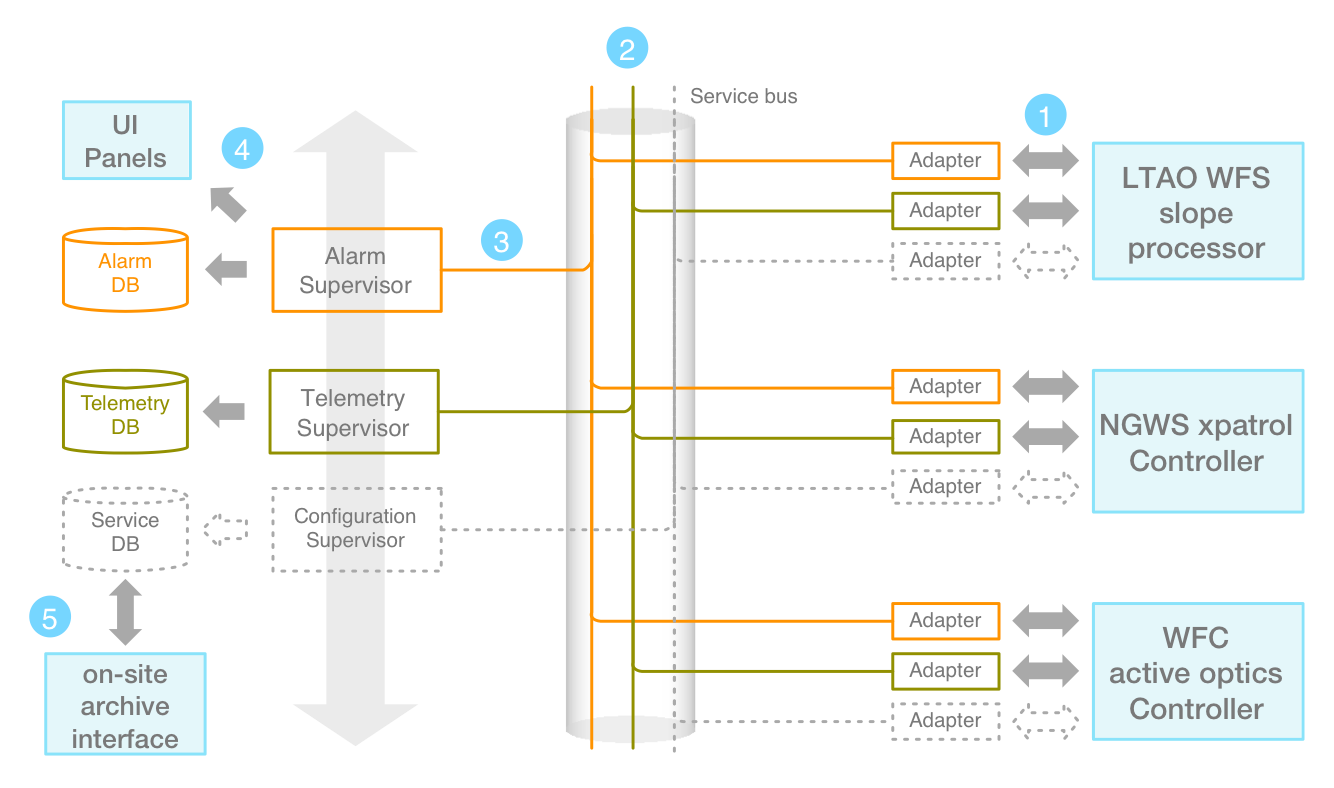6.1. Service Architecture#
The implementation of the common services follows a distributed architecture (see following figure) in which service adapters allow distributed components to access the service bus, while service supervisors coordinate services. Service adapters define the low-level interface between components and observatory services. Communication between adapters and supervisors may follow different communication patterns (e.g., publish/subscribe, push/pull, request/reply). The Section on Core Framework describes the different communication patterns that are available.

Fig. 6.2 Common Services Architecture. (1) Components access the service through the adapter API when an event is generated (e.g., alarm detected). (2) The “payload” (e.g. alarm event, telemetry sample) is transported from adapter to supervisor through the Service Bus. (3) Service Supervisors coordinate services, and process the service payload when received. (4) The service payload is stored and/or forwarded to components that subscribe to the service. (5) Operators can filter or cross-correlate any persistent data stream for further analysis. .. _service_adapters:#
Requirement |
Statement |
|---|---|
Architecture |
Establish an architecture for instrument software and control subsystems. |
Reference Model |
Provide a reference model to design control subsystems in a consistent way. |
Semantic Model |
Provide a method to specify formally the features and capabilities provided by every subsystem. |
Software/Hardware Standards |
Establish a set of software/hardware standards (GMT_SWC- REF-00029) for the project. |
6.1.1. Service Adapters#
Service adapters enable every distributed component in the system to access infrastructure common services. They serve as the low level interface between hardware and software components and observatory services. Service adapters help to:
Isolate distributed components from service implementation. This helps to manage obsolescence in hardware and software.
Focus application developers on developing applications (e.g. control, data processing). Application developers should not need to solve infrastructure problems that are common to all subsystems.
Standardize base implmentation. A base component (in an object oriented sense) implementation provides a template for all service adapters to bootstrap from.
Simplify interaction and deployment. Software components need to only know about the service native API, and not how the service or distributed communication are implemented. They hide details like how to manage connection, service threads, marshaling and de-marshaling of events and data streams, time stamps, middleware configuration, optimal communication pattern, how to register component services in runtime database.
Base classes in the Core Component Framework wrap these low-level interfaces in a simplified high-level application-programming interface (API), reducing the overhead necessary to integrate a software component into the GMT system. When a component is deployed and its service adapters setup and bootstrapped, all the component service features become available system-wide. Service adapters can be shared between components depending on the performance requirements.
The adapter hides from the component service implementation details like:
Connection management
Service Thread management
Marshaling and de-marshaling of event and data streams
Time stamping of events
Specific middleware setup
Implementation of optimal communication patterns
Registering of component service functions in the runtime database
Communication between adapters and supervisors may follow different communication patterns (e.g., publish/subscribe, push/pull, request/reply). The Section on Core Framework describes the different communication patterns that are available.
6.1.2. Service Supervisors#
Service supervisors coordinate and maintain the health status of the services. Some services may require several servers running in a cluster, or may connect to a high performance file system for persistent high throughput events or data streams. The service supervisor provides the following capabilities:
Archiving of the data and event streams coming from service adapters
Implementation of optimal communication pattern
Archiving of the service configuration data
Service analytics and reporting
Monitoring the health of the service adapters (the System Supervisor is responsible for monitoring the health of the different Service Supervisors)
Publish/subscribe access to the data and event streams
Load balancing
Fault tolerance
Scaling due to bandwidth or growing storage demands (e.g., new systems added to the observatory)
Visualization of service data
Cross filtering of multidimensional datasets.
The implementation of the service supervisors is not monolithic. Depending on the prevailing communication patterns, it is possible to implement different ways to distribute the process workload (e.g., broker, fan-out). This allows the efficient use of computing resources and elastic adaptation to the load.
6.1.3. Service Bus#
A dedicated service bus connects Service Adapters and Service Supervisors. Each service bus provides a logical network connection that addresses the specific throughput, bandwidth and latency requirements of the service. The Section on the networking platform provides a description of the GMT networking infrastructure.